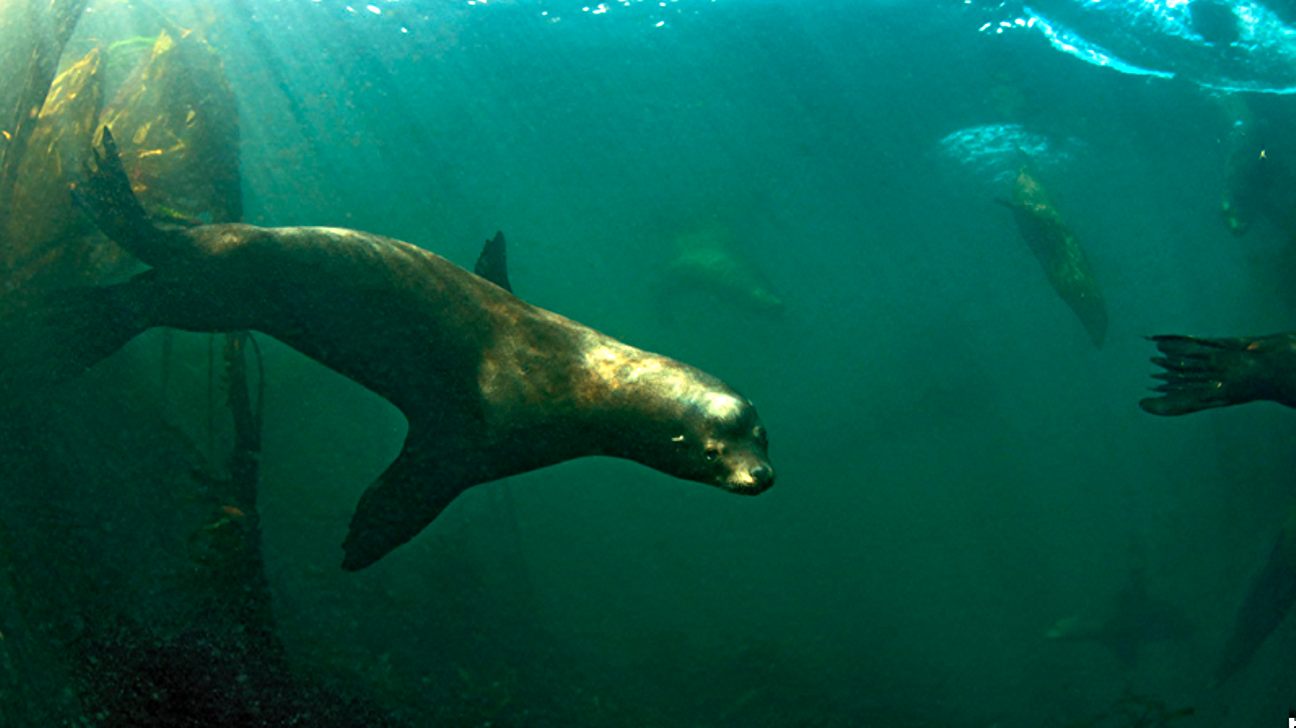
California sea lion photo by Ryan Murphy
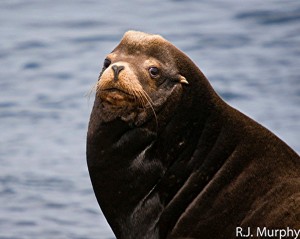
Male California sea lion– note ears;
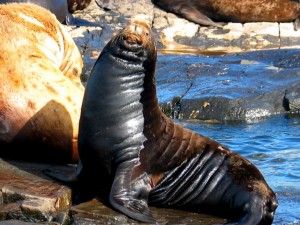
California sea lion. still wet and therefore almost black. When they are dry they are dark brown. G.Fletcher photo.
California sea lions are known for their intelligence, playfulness, and noisy barking. Their color tends toward chocolate brown, although females are often a lighter golden brown. Males may reach 1,000 lbs. (more often 850 lbs.or 390 kg) and 7 feet (2.1 m) in length. Females grow to 220 lbs. (110 kg) and up to 6 feet (1.8 m) in length. They have a “dog-like” face, and around five years of age, males develop a bony bump on top of their skull called a sagittal crest. The top of a male’s head often gets lighter with age. These members of the Otariid, or walking seal, family have external ear flaps and are equipped with large flippers which they use to “walk” on land.
The trained “seals” in zoos and aquaria are usually California sea lions.
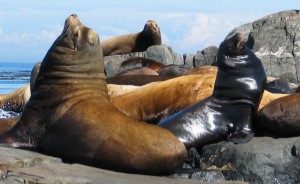
Dry sea lion on the left and wet one on the right with a northern sea lion lying behind them. Sept 2006-G.Fletcher photo
In this picture they are seen mixed in with the Northern Sea Lions on many of the islands at Race Rocks. They do prefer however, West Rock, North Rock and the North West corner and the docks area of Great Race Rocks.
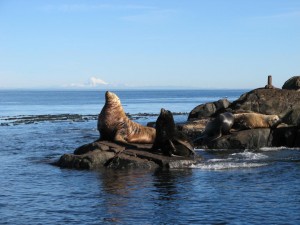
Northern and California Sea lion with Mt Baker in the background. photo: G.Fletcher
In 1970 , Trevor Anderson reported to David Hancock for the Journal article “California Sea Lion as a Regular Winter Visitant off the British Columbia Coast” that ” California Sea Lions had hauled out on rocks near the light every winter since 1966…. and a peak of population of 30 was reached in February, 1969.”
It is clear that the population of these animals has risen considerably over the years, and by 2007, up to 300 may haul out in the fall of the year.
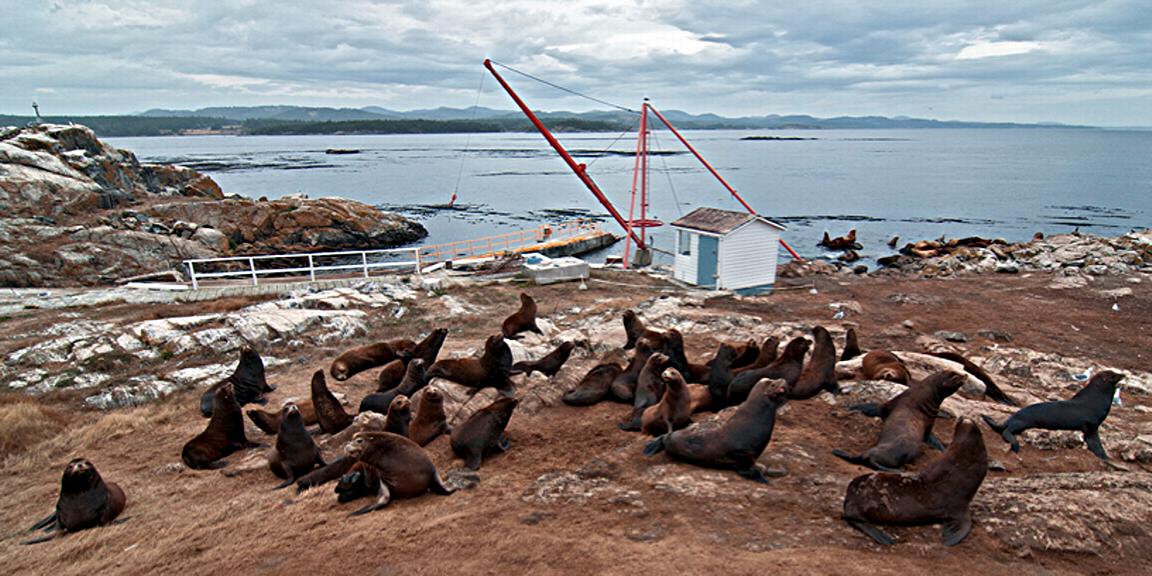
In the fall of 2011, the California sea lions were especially attracted up near the house in mid September . They all departed when an earthquake struck the north end of Vancouver island. Ryan Murphy photo
BREEDING
Sea lions do not pup at Race Rocks, it is strictly a winter haulout colony. Most pups are born on the outer coast to the South in June or July and weigh 13-20 lbs. (6-9 kg). They nurse for at least 5-6 months and sometimes over a year. Mothers recognize pups on crowded rookeries through smell, sight, and vocalizations. Pups also learn to recognize the vocalizations of their mothers. Breeding takes place a few weeks after birth. Males patrol territories and bark almost continuously during the breeding season. Gestation lasts about 50 weeks and lactation 5 to 12 months. The longevity is estimated to be around 17 years.
FEEDING HABITS
California sea lions are opportunistic feeders and eat such things as squid, octopus, herring, rockfish, mackerel, anchovy and whiting. The California sea lion competes with the Northern Sea Lion Eumetopias jubata for habitat and food
NOTES
California sea lions are very social animals, and groups often rest closely packed together at favored haul-out sites on land, or float together on the ocean’s surface in “rafts.” They are sometimes seen porpoising, or jumping out of the water, presumably to speed up their swimming. Sea lions have also been seen “surfing” breaking waves.
The males are probably the most vocal of all mammals, and let out a loud incessant honking bark to protect over their territories. They are faithful to their territories, and to their harems of up to 15 females. Sea Lions swim up to 25mph which makes them one of the fastest aquatic carnivores.
Sea lions are known to damage fishing gear and steal or destroy fish in the nets. As a result a lot of California sea lions drown in nets and they are frequently shot at by commercial fishers.
See examples below and in the video.
Sea lions are preyed upon by killer whales. Sea lions are known to have such diseases as pneumonia, caused by a parasitic lungworm, and a bacterial infection called leptospirosis, which affects their livers and kidneys.
Other problems for California sealions involve humans. Sea lions have been found illegally shot and also caught in drift or gill nets and other marine debris. However, their population is growing steadily, and California sea lions can be seen in many coastal spots
The Californian Sea lion was once killed in great numbers for their blubber which could be made into oil, and the rest would be made into dog food. Today the seal lion is protected by international treaty which has led to a positive shift in their populations.
Domain Eukarya
Phylum: Chordata
Class: Mammalia
Order: Pinnipedia
Family: Otariidae
Genus: Zalophus
Species: californianus
Common Name: California Sea Lion
-
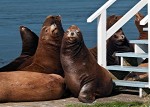
-
California sea lions at the stairs to the main residence.
-

-
In late August, the California Sea Lions arrive back in large numbers from the outer coast . By the end of October, they often number over 1000.Sea lion mixed species on middle island .G.Fletcher photo
-
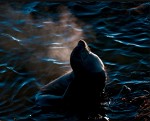
-
The sun had just come up when Ryan snapped this picture of the sea lions breath. RM photo
-
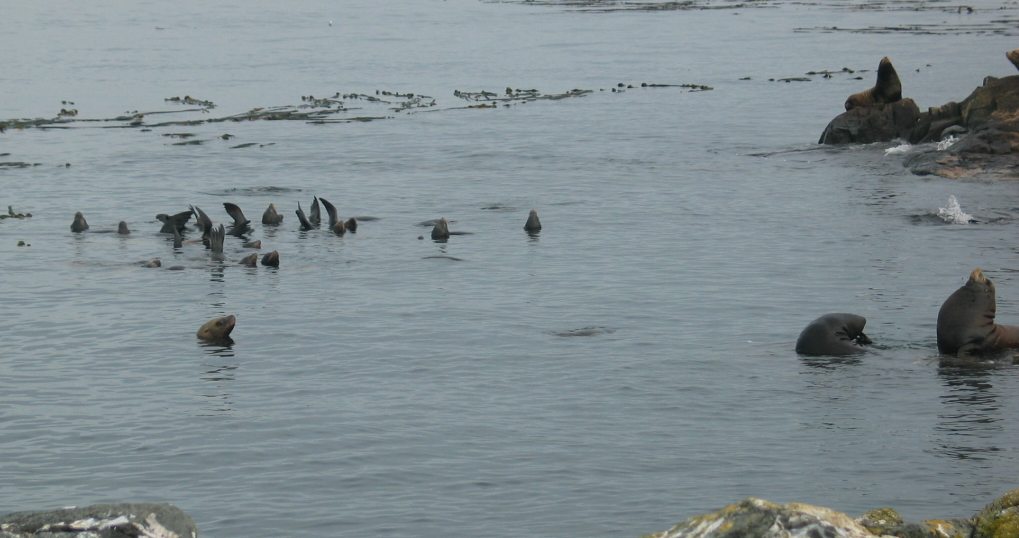
-
California Sea Lions rafting in front of the docks.
-
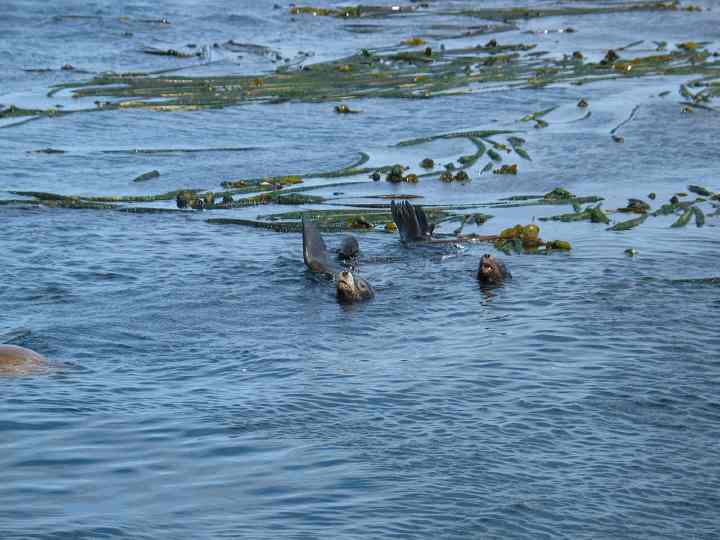
-
The flippers are filled with blood vessels, so this behaviour allows heat exchange with the atmosphere.
-
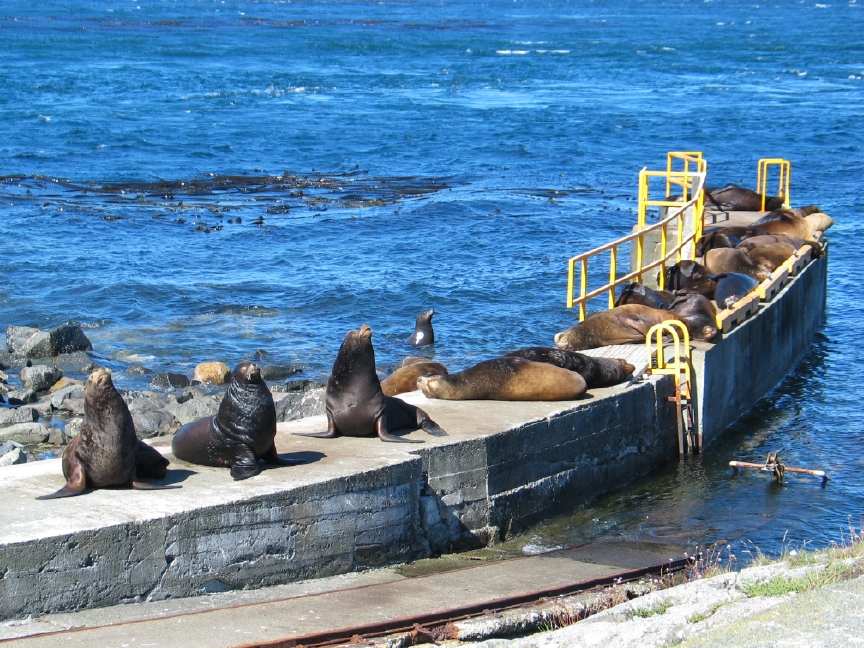
-
Sept. 2007. California sea lions return to the docks as soon as he boat leaves.
-
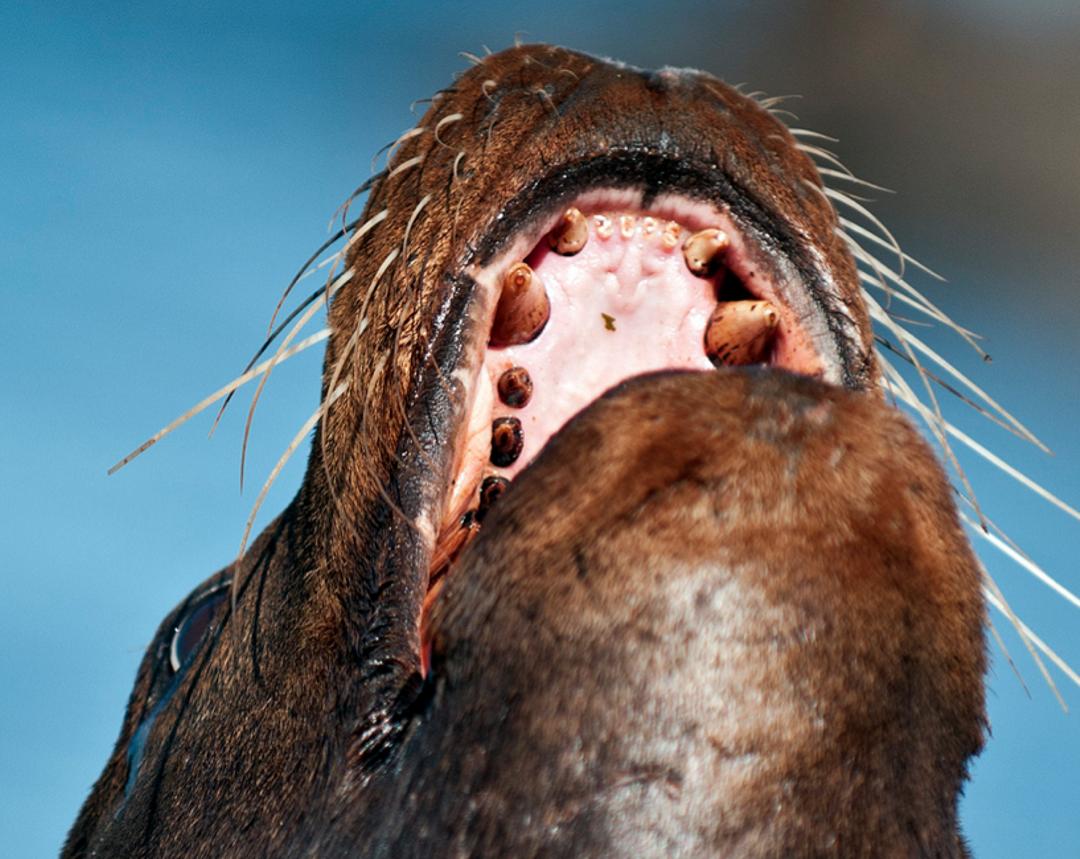
-
Teeth of California Sea Lion: Photos by Ryan Murphy
-
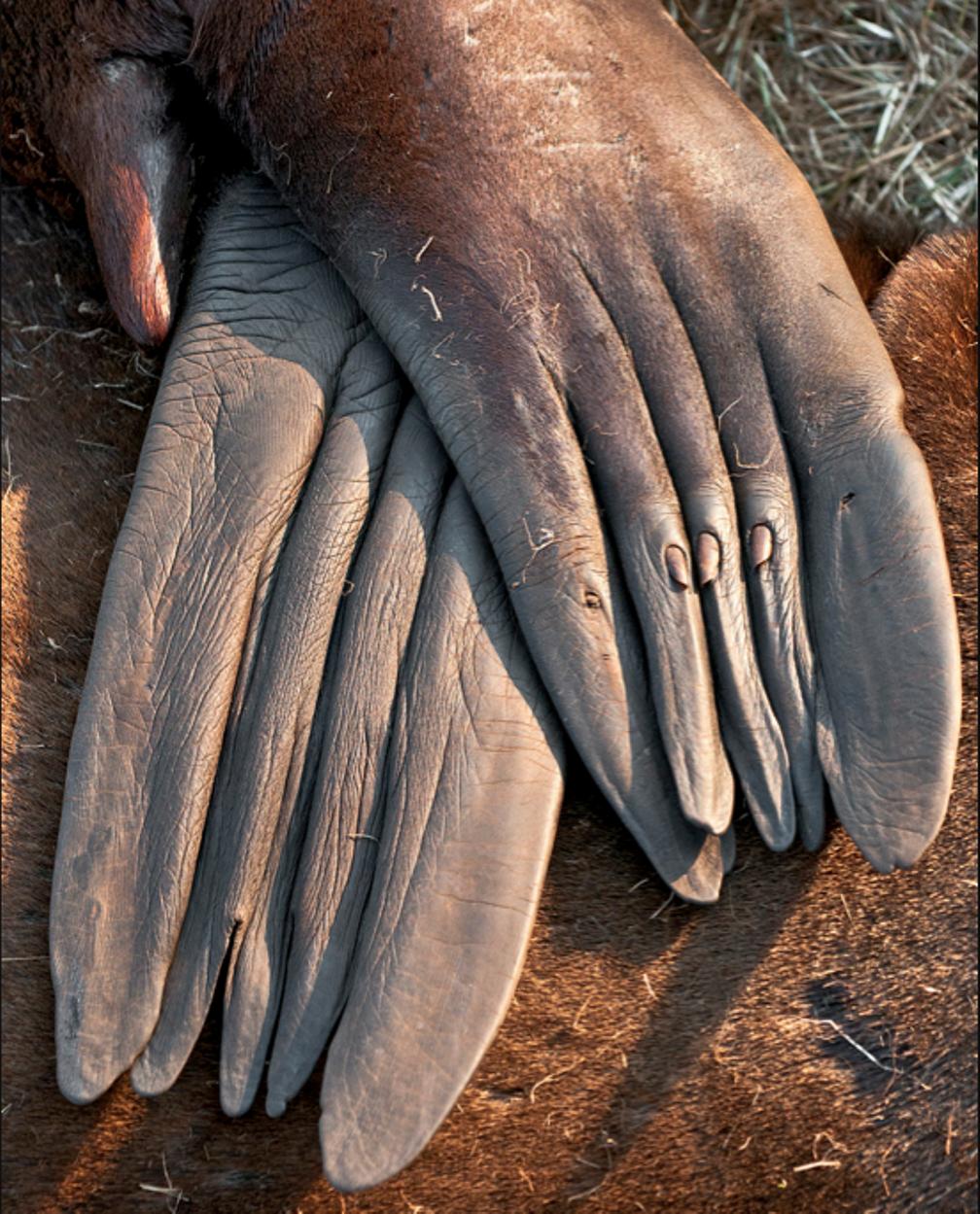
-
Rear flippers,dorsal and ventral sides
-
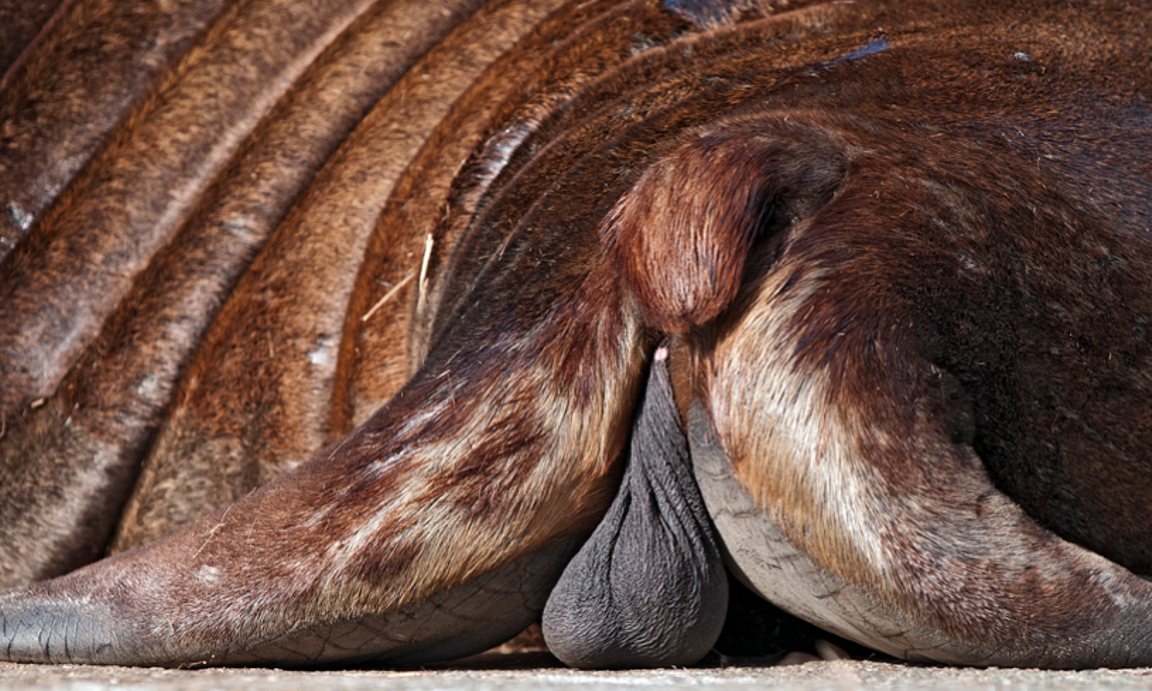
-
Scrotum of Zalophus californianus
|
ARCHIVED VIDEOS of Sea lions at Race Rocks |
|
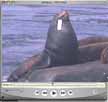 September, 2003 : This past few months we have seen three California and Northern Sea lions with fishing flashers hanging from their mouths. These animals pursue fishing lures , probably especially when live bait is used. They swallow the bait, and take down the meter plus length of leader line before the flasher comes to their mouth. The individuals will be seen for several days trailing these flashers. It is not known whether they eventually shed the flasher or whether this leads to an untimely death. Although they can pick up a flasher in waters at some distance from their haulouts, it certainly makes sense to restrict fishing activity when marine mammals are in the vicinity of a fishing vessel. September, 2003 : This past few months we have seen three California and Northern Sea lions with fishing flashers hanging from their mouths. These animals pursue fishing lures , probably especially when live bait is used. They swallow the bait, and take down the meter plus length of leader line before the flasher comes to their mouth. The individuals will be seen for several days trailing these flashers. It is not known whether they eventually shed the flasher or whether this leads to an untimely death. Although they can pick up a flasher in waters at some distance from their haulouts, it certainly makes sense to restrict fishing activity when marine mammals are in the vicinity of a fishing vessel. |
|
 From August to November, a group of California sea lions hauls out on the shore to the East of the Docks with a few even staying on the docks. They get very used to the boats docking there and are often joined by a few large Northern sea lions as well. The constant barking sound comes from the California Sea lions, and the low growls are from the Northerns.” From August to November, a group of California sea lions hauls out on the shore to the East of the Docks with a few even staying on the docks. They get very used to the boats docking there and are often joined by a few large Northern sea lions as well. The constant barking sound comes from the California Sea lions, and the low growls are from the Northerns.” |
|
 Effects of DND Blasting at Bentinck Island: On November 7, 2002, the DND were still doing their demolition blasting exercises at Bentinck Island. (not Oct 7 as stated in this draft version of the video) The students from Lester Pearson College who were out for a project week were able to catch the images of the impact of these blasts on the first day from the science centre window and on the second day from the top of the light tower. In the tower, they interviewed Mike Demarchi of LGL who is currently doing a $50,000 contract for the Department of National Defence to monitor the impact of these blasts and to compare them with other disturbances at Race Rocks. ( Click on audio icon below) Effects of DND Blasting at Bentinck Island: On November 7, 2002, the DND were still doing their demolition blasting exercises at Bentinck Island. (not Oct 7 as stated in this draft version of the video) The students from Lester Pearson College who were out for a project week were able to catch the images of the impact of these blasts on the first day from the science centre window and on the second day from the top of the light tower. In the tower, they interviewed Mike Demarchi of LGL who is currently doing a $50,000 contract for the Department of National Defence to monitor the impact of these blasts and to compare them with other disturbances at Race Rocks. ( Click on audio icon below) |
|
 Ecotourism can have both positive and negative effects. In this video, you see twoecotourist whale-watching boats from Victoria B.C. that demonstrate two methods of viewing marine mammals. The yellow boat, the Prince of Whales rounds the middle rock inside the kelp bed, much too close to the island which is covered with northern sea lions and a few California sea lions. Since the animals on the North side of the island do not see the boat coming at this close distance, theyare startled and about 25 of them take to the water. Thehigh profile of the boatis increased by the individuals standing on the top of the boat, probably adding to the scare value.The other boat, the Discovery Launch, comes down the main passage between Great Race and the middle rock. They have approached slowly, drift with the current and present very little impact on both the sea lions on the middle rock and the harbour seals hauled out on the main island down in the foreground. Missing from this video however is video of their departure from the reserve where they swing in very close to the end of the docks, causing a stampede of a dozen sea lions in that areaThere are definite guidelines on viewing distance which are occasionally ignored by commercial operators and by private boats of the public that come into the reserve. Disturbance of any marine mammal colonies by vessel operators is against the law. Every time an animal has to change it’s behaviour because of human behaviour, there is a cost in terms of energy expenditure. Violations of this regulation should be reported to federal fisheries.If you feel you would like to provide feedback on this issue to the Department of Fisheries see contact information in this booklet on their Guidelines Ecotourism can have both positive and negative effects. In this video, you see twoecotourist whale-watching boats from Victoria B.C. that demonstrate two methods of viewing marine mammals. The yellow boat, the Prince of Whales rounds the middle rock inside the kelp bed, much too close to the island which is covered with northern sea lions and a few California sea lions. Since the animals on the North side of the island do not see the boat coming at this close distance, theyare startled and about 25 of them take to the water. Thehigh profile of the boatis increased by the individuals standing on the top of the boat, probably adding to the scare value.The other boat, the Discovery Launch, comes down the main passage between Great Race and the middle rock. They have approached slowly, drift with the current and present very little impact on both the sea lions on the middle rock and the harbour seals hauled out on the main island down in the foreground. Missing from this video however is video of their departure from the reserve where they swing in very close to the end of the docks, causing a stampede of a dozen sea lions in that areaThere are definite guidelines on viewing distance which are occasionally ignored by commercial operators and by private boats of the public that come into the reserve. Disturbance of any marine mammal colonies by vessel operators is against the law. Every time an animal has to change it’s behaviour because of human behaviour, there is a cost in terms of energy expenditure. Violations of this regulation should be reported to federal fisheries.If you feel you would like to provide feedback on this issue to the Department of Fisheries see contact information in this booklet on their Guidelines |
|
 DND blasting at Bentinck Island.This video was made on October 7, 2002 in order to document the effect of the Department of National Defence demolition exercises on Bentinck Island on the behaviour of birds and marine mammals at Race Rocks MPA. In previous years we have observed considerable disruption by military exercises involving blasting on nearby Bentinck Island in the fall just after the sea lions have returned to the island. We have requested that blasts be spread out over a longer period of time during an exercise. Traditionally blasts have come in a series of three. The first one would alert the sea lions, the second would send a few in the water and the third would clear the islands. This year on this one occasion, only two blasts were held at five minutes apart. The results are shown in the video. DND blasting at Bentinck Island.This video was made on October 7, 2002 in order to document the effect of the Department of National Defence demolition exercises on Bentinck Island on the behaviour of birds and marine mammals at Race Rocks MPA. In previous years we have observed considerable disruption by military exercises involving blasting on nearby Bentinck Island in the fall just after the sea lions have returned to the island. We have requested that blasts be spread out over a longer period of time during an exercise. Traditionally blasts have come in a series of three. The first one would alert the sea lions, the second would send a few in the water and the third would clear the islands. This year on this one occasion, only two blasts were held at five minutes apart. The results are shown in the video.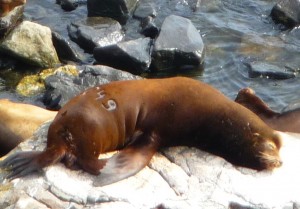 BRANDING:We often encounter marine mammals in the reserve which have been marked when trapped in another location as part of a scientific study. We are including in this file a set of pictures of marine mammals which have been tagged in various studies, along with the particulars of the observations. BRANDING:We often encounter marine mammals in the reserve which have been marked when trapped in another location as part of a scientific study. We are including in this file a set of pictures of marine mammals which have been tagged in various studies, along with the particulars of the observations. 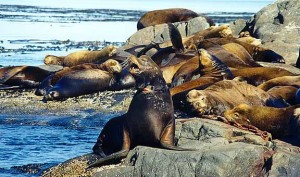 ENTANGLEMENT: ENTANGLEMENT:
In September 1999, this California sealion, with a plastic hoop around his neck, was photographed from the docks at Race Rocks by MPA Guardian Carol Slater.
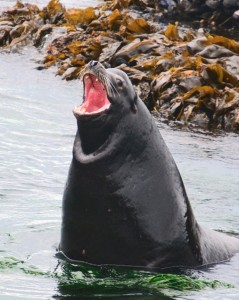
A sea lion with a plastic ring on his neck. See this file for our posts on “entanglement”. It shows the many examples of human debris compromising the health of sea lions.Sometimes however, there is a good news story. It seems like this California sea lion has made somewhat of a recovery, with skin growing over the plastic. See this and other images by . Ryan Murphy in his Flickr album.
SUBSPECIES
Three subspecies are recognized: Zalophus californianus californianus (Lesson, 1828), Zalophus californianus wollebaeki (Sivertsen, 1953) and Zalophus californianus japonicus (Peters, 1866), each living in a clearly separate range. According to Rice (1998), the differences between these types justifies classification as separate species: Zalophus californianus, Zalophus wollebaeki and Zalophus japonicus
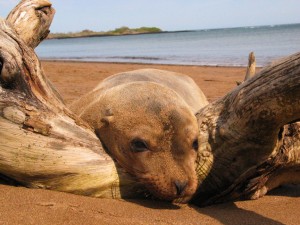
Ecological Equivalents: The subspecies Zalophus wollebaeki sea lion from the Galapagos Islands.
|
Other Members of the Class Mammalia at Race Rocks.

























